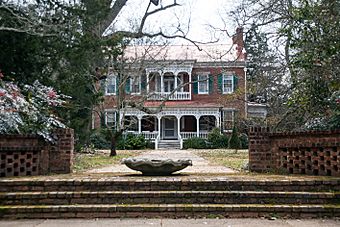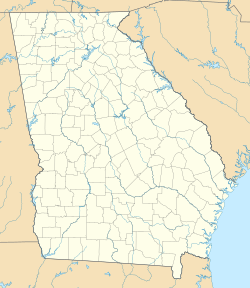Bonar Hall facts for kids
Quick facts for kids |
|
|
Bonar Hall
|
|
 |
|
| Location | 962 Dixie Avenue Madison, Georgia 30650 |
|---|---|
| Area | 10 acres (4.0 ha) |
| Built | 1839 |
| Architectural style | Late Georgian |
| MPS | Madison Historic District |
| NRHP reference No. | 72000388 |
| Added to NRHP | January 20, 1972 |
Bonar Hall is a beautiful old house in Madison, Georgia. It was built between 1839 and 1840. This grand home shows the style of the Georgian era. It was one of the first large houses built when Madison was growing fast. This period, from 1840 to 1860, was a time of great wealth for the town. In 1972, Bonar Hall was added to the National Register of Historic Places. This means it is an important historical site.
The house is a two-story brick building. It was built by John Byne Walker and his wife, Eliza Fannin. Eliza was the half-sister of James W. Fannin, Jr.. He was a famous commander during the Texas Revolution. Eliza inherited the land for the house from her father, Isham Fannin. He was one of the people who helped start Madison and Morgan County.
Contents
Building Bonar Hall: A Grand Start
The first bricks for Bonar Hall were laid on February 25, 1839. These bricks were made on John Byne Walker's own land. The brick kitchen was built first. All the brickwork was finished by early July of that year. The Walkers moved into their new home about 10 months later.
Original Design and Features
An unknown professional architect designed the main house. It was first called the John Byne Walker Townhouse. It had a traditional Georgian style with four rooms on each of its two floors. Each room was very large, about 20 by 20 feet. The house had eight fireplaces and very thick walls, about 18 inches wide. The ceilings were high, at 13 feet, and the doorknobs were made of silver.
The house had a small, one-story front porch with four white columns. On either side of the main house were small brick buildings. These were called "summer houses" and are now a tea house and an orangery. In the back, there was a three-room brick kitchen. It had two matching brick outhouses on either side.
The Estate Today
Today, the Bonar Hall estate covers about 13-acre (53,000 m2). It includes several other historic buildings. There is a two-room cabin from downtown Madison, built around 1810-1815. This is one of the oldest buildings in the town. There is also a cabin from around 1830, likely for enslaved people. A tenant house from about 1900 is also on the property.
Other buildings include a classic Victorian carriage house from the 1880s. There's also a log smokehouse from the 1920s and a working well. A special feature is the formal boxwood garden. It dates back to around 1850. This garden is famous and has been written about in many books.
John Byne Walker: A Wealthy Planter
John Byne Walker was a very successful cotton planter. He was one of the richest men in Morgan County before the Civil War. He owned many enslaved people and vast amounts of land. He had about 4,000 acres (16 km2) in Morgan County, Georgia. He also owned 6,000 acres in Wharton County, Texas. He traveled to Texas every year between 1846 and 1862.
Walker was one of the first people to support the Georgia Railroad. He was also a major supporter of the Baptist Church in Madison. He donated all the bricks for the Madison First Baptist Church, built in 1858. Bricks from Walker's plantations were also used for other important buildings. These included the train depot (1840), the Presbyterian church (1842), and the Baptist College (1849). The Baptist College was later renamed the Georgia Female College.
Bonar Hall During the War Years
All of the Walkers' sons joined the Panola Guards, a military group. One of their sons was badly wounded at the Battle of Gettysburg. Because John Byne Walker had strong connections to Texas, the family opened their home to wounded soldiers. Many of these soldiers were from the Texas Rangers.
After the Battle of Chickamauga in 1863, Bonar Hall became a temporary hospital. For almost a year, up to 20 Texas Rangers were cared for there at a time. A chaplain and war reporter named Rev. Robert F. Bunting visited often. He made Bonar Hall the "Texas Depot" for mail. All letters from Texas families were sent there to be forwarded to the soldiers. The war caused John Byne Walker to lose his wealth. He died without money.
The Broughton Family Era
In 1880, the prominent Broughton family bought Bonar Hall. John Broughton bought the house as a wedding gift for his son, William A. Broughton. The Broughtons made many changes to the house. They added an elaborate Victorian porch to the front, replacing the original one. They also decorated the ceilings in the double parlor with stencils. The Victorian carriage house was also added during their time. Mr. Broughton passed away in 1902. About ten years later, Mrs. Broughton sold the house. She moved to Mobile to be with her daughter and other family.
The Newton-Bacon Years: A Family Legacy
In 1920, Mrs. Josie Bacon bought Bonar Hall. She was a cotton plantation owner. Her family had moved from Virginia to Greene County in the late 1700s. They claimed land given to her great-great-grandfather, Douglas Watson, for his service in the American Revolutionary War. Mrs. Josie Bacon was also related to Eliza Fannin, the original owner.
She had lived for 14 years at the nearby Carter-Newton House. When she moved to Bonar Hall, she brought all her family's furniture. This included a large mirror from Atlanta's historic Kimball House hotel. She also had a 14-foot (4.3 m) table. General William T. Sherman and his troops reportedly ate on this table. Mrs. Bacon named the house after one of her oldest relatives, Charles Bonar. A portrait of his son, William Bonar (from around 1760), hangs in the sitting room.
A Family of Influence
Mrs. Josie's husband, William T. Bacon, grew up in Lexington, Georgia. He was the first editor-in-chief of the UGA student newspaper, The Red and Black. He was also the editor of The Madisonian newspaper for 50 years. He even served as a State Senator. In 1968, he was honored by being elected to the Georgia Newspaper Hall of Fame after his death. His photograph is displayed at UGA's Grady College of Journalism.
Mrs. Josie's daughter, Therese Newton, inherited the house. She was a close friend of the famous adventurer, Robert L. Ripley. He was known for his "Ripley's Believe It or Not!" stories. Therese visited him often at his large mansion until he passed away in 1949. Ripley even gave her two dalmatian dogs around 1948. The two sturdy dog houses in the back of Bonar Hall were built for them.
Restoration and Filming
After Therese Newton's death in 1994, her nephew, Alex Newton, and his wife, Betsy Wagenhauser, worked hard to restore the house and grounds. This took almost two decades. They rebuilt the front brick wall with a special diamond design. They also rebuilt one of the matching brick outhouses in the back.
Today, portraits of the original owners and their relatives hang in the double parlor. There is also a portrait of Mattie Walker, the Walkers' youngest daughter. In 2004, Bonar Hall was used as the main set for the Emmy-winning film Warm Springs. This movie was about Franklin D. Roosevelt's struggle with polio in the 1920s. Kenneth Branagh played Roosevelt, Cynthia Nixon played Eleanor, and Kathy Bates played his therapist.


